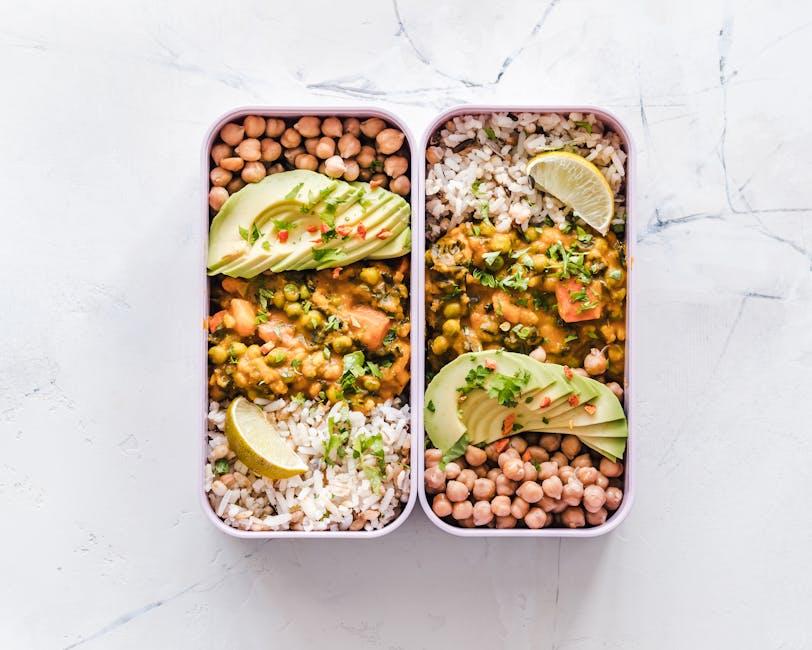Table of Contents
- Creating Delicious Meals on a Budget
- Smart Grocery Shopping Tips for Thrifty Eaters
- Meal Prep Strategies to Save Time and Money
- Affordable Recipes That Don’t Compromise on Taste
- Stretching Your Food Budget Without Sacrificing Nutrition
- Q&A
- The Conclusion


Creating Delicious Meals on a Budget
Eating well without breaking the bank can be a delightful challenge that gets your creative juices flowing in the kitchen. Embrace seasonal ingredients, which are typically fresher and cheaper. For example, cooking with autumn’s bountiful pumpkins, squash, and apples can yield numerous cozy recipes. Consider versatile staples like beans, rice, and oats—these are not only inexpensive but also incredibly adaptable across different meals. The trick is to learn how to blend these components in novel ways, ensuring varied textures and flavors.
- Plan Ahead: Draft a weekly menu to minimize food waste and impulse buying. This approach lets you harness sales and offers with precision.
- Batch Cook: Prepare large portions and freeze them for future use. This time-saver also reduces reliance on costly convenience foods.
- Embrace Leftovers: Reinvent your previous day’s dishes into new culinary adventures, enhancing both sustainability and economy in the kitchen.
| Ingredient | Cost Saving Tip |
|---|---|
| Chicken | Buy whole and utilize every part, from breasts to stock using bones. |
| Vegetables | Purchase frozen to extend shelf life and reduce waste. |
| Herbs | Grow your own or buy dried variations for longer-lasting flavor. |


Smart Grocery Shopping Tips for Thrifty Eaters
Maximizing your grocery budget doesn’t have to be a daunting task. One effective strategy is to plan your meals around weekly sales and seasonal produce. Fruits and vegetables that are in season are not only more affordable but often packed with more flavor and nutrition. Check your local store’s flyer before heading out to make a list of on-sale items. Create versatile meal plans that can adapt to whatever is discounted, thus allowing you to save without compromising on variety. By doing so, you’re not only saving money but also reducing waste by utilizing everything you buy efficiently.
Embrace the power of the generic or store brands, which often provide the same quality as name-brand items at a significantly lower price. When you spot deals like “buy one, get one free” or “income-saving bundles,” it’s wise to do some quick math to ensure you’re getting the best value per unit. Compare the price per ounce or unit, which is typically displayed on the shelf tag, to identify the true cost savings. Investing in bulk staples such as grains, canned goods, or frozen produce can pay off, especially if there’s room to store them properly at home.
| Item | Brand | Price per Unit | Total Cost |
|---|---|---|---|
| Rice | Store | $0.03 | $6.00 |
| Canned Tomatoes | Store | $0.99 | $11.88 |
| Broccoli (Frozen) | Generic | $0.07 | $3.50 |
Another practical tactic is to avoid shopping on an empty stomach. It may sound trivial, but studies show that hunger can influence both the quantity and the types of items you decide to purchase. Stick to your predefined list and keep an eye out for opportunities to apply digital coupons available through shopping apps or retailer websites. These platforms often offer exclusive discounts or points systems that can be redeemed for future savings. Planning ahead—including stock reminders and avoiding dining out impulsively—can dramatically trim your grocery expenses, paving the way towards a more frugal and strategic food plan.


Meal Prep Strategies to Save Time and Money
Embrace the power of batch cooking as a cornerstone of your weekly routine. By dedicating just a few hours on the weekend, you can prepare multiple meals in one go, reducing both time spent in the kitchen during busy weekdays and overall grocery expenses. Focus on versatile recipes that can be easily scaled, such as hearty stews, nourishing soups, and grain bowls. These dishes not only provide balanced nutrition but can also be conveniently tailored with varying toppings and sides to keep things interesting throughout the week.
Another effective strategy is ingredient prep, which involves cleaning, chopping, and storing your produce in advance. This way, you can swiftly combine these components to create fresh meals in minimal time. Stock your pantry with staples like rice, pasta, and canned goods that can complement your prepped ingredients, allowing for quick, creative culinary combinations. Here are a few essentials that will keep your meal prep efficient and diverse:
- Whole grains: Brown rice, quinoa, and oats
- Canned beans: Chickpeas, black beans, lentils
- Frozen vegetables: Spinach, peas, mixed veggies
To further optimize your meal prep journey, consider establishing a weekly meal plan. Craft a schedule that outlines each meal, ensuring you’re utilizing every ingredient to its fullest potential. This tactic significantly cuts down on food waste and allows you to identify budget-friendly supermarket deals effectively. A WordPress table, as shown below, can serve as an excellent organizational tool, offering a clear visual reference point for your planned dishes:
| Day | Lunch | Dinner |
|---|---|---|
| Monday | Quinoa salad with chickpeas | Vegetable stir-fry |
| Tuesday | Lentil soup | Pasta with tomato and spinach |
| Wednesday | Grain bowl with roasted veggies | Black bean tacos |


Affordable Recipes That Don’t Compromise on Taste
When managing a tight budget, it’s essential to focus on ingredients that can be transformed into multiple delightful meals. Pasta is a prime example where versatility meets affordability. With variations such as spaghetti aglio e olio, packed with garlic and chili flakes, to a creamy tomato basil penne, the possibilities are endless. For a boost of nutrition, consider mixing in vegetables like spinach or zucchini.
- Lentil Soup: Rich in protein and fiber, lentils are an excellent meat substitute. Spice it up with cumin and coriander for a warming meal.
- Egg Fried Rice: With leftover rice, a couple of eggs, and a handful of frozen peas, you can whip up a satisfying dish in no time.
- Chickpea Salad: Combine canned chickpeas with diced cucumber, cherry tomatoes, and herbs. Dress with olive oil and lemon for a Mediterranean touch.
| Recipe Name | Main Ingredients | Estimated Cost |
|---|---|---|
| Spaghetti Aglio e Olio | Pasta, Garlic, Olive Oil | $3.00 |
| Lentil Soup | Lentils, Onion, Spices | $4.50 |
| Chickpea Salad | Chickpeas, Cucumber, Herbs | $2.75 |


Stretching Your Food Budget Without Sacrificing Nutrition
In an era where everything seems to be getting more expensive, finding ways to make your food dollars stretch further while still maintaining a balanced diet can be challenging. By understanding a few key strategies, you can prioritize nutrition without breaking the bank. One effective approach is to focus on versatile ingredients that can be used in multiple meals. Think staples like beans, rice, and frozen vegetables, which not only have a long shelf life but can be incorporated into diverse recipes such as soups, stews, and casseroles. Investing in these multipurpose items allows for variety in your meals, reducing boredom and ensuring nutrient intake remains balanced.
When shopping, it’s wise to look beyond the traditional grocery store. Farmers’ markets, discount stores, and buying in bulk can lead to significant savings. Bulk buying is particularly effective for items like grains and spices, which can be stored for extended periods. Another budget-friendly strategy is to explore less-popular cuts of meat, which are often cheaper and can be just as tasty. A slow cooker or pressure cooker can be valuable tools here, transforming tough cuts into delicious, tender meals.
| Ingredient | Cost-Effective Option | Nutritional Benefit |
|---|---|---|
| Protein | Lentils | High in fiber & protein |
| Vegetables | Frozen spinach | Rich in iron & calcium |
| Fruit | Seasonal apples | Vitamin C & antioxidants |
Planning is a pivotal part of stretching your food budget. Take advantage of weekly sales and coupons to purchase staples you’ll use regularly. Cooking in larger batches is also a smart move. Prepare meals that can be frozen and reheated during busy weeks, ensuring you always have access to wholesome, home-cooked meals. This not only saves money but also reduces impulsive spending on takeout during hectic days. Ultimately, by adopting these strategies, you can create a nutritious and affordable food plan that meets your dietary needs without exceeding your budget.




0 Comments